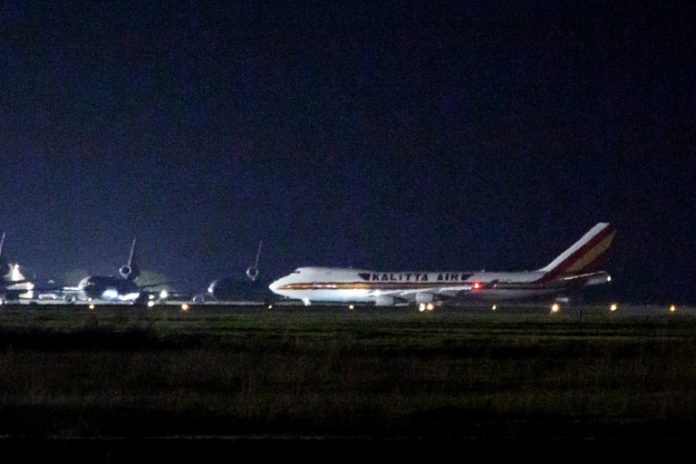More than 300 Americans rescued from a cruise ship quarantined off Japan because of the new coronavirus arrived back in the United States Monday for two more weeks of medical seclusion, as concern rose over passengers who dispersed around the globe after leaving another ship in Cambodia.
The COVID-19 virus death toll exceeds 1,800 in China, where it has infected more than 72,000. Elsewhere, hundreds more have been infected and the virus has sparked panic buying, economic jitters as well as the cancellation of high-profile sporting and cultural events.
With fresh cases emerging daily in Japan, the government has advised citizens to avoid mass gatherings, and has canceled public events – including celebrations in central Tokyo for the Emperor’s birthday and the amateur portion of the city marathon, affecting around 38,000 runners.
In the Chinese capital Beijing, municipal authorities have ordered citizens arriving in the city to self-quarantine for 14 days, the presumed incubation period of the virus.
State media said China may postpone its annual parliamentary session, which has been held in March for the last 35 years.
Outside China, the biggest cluster of infections is from the Diamond Princess cruise ship off Japan’s Yokohama, where an additional 99 cases were revealed on Monday.
That brought the total to 454 diagnosed despite passengers being confined to their cabins during a 14-day quarantine.
As criticism grew of Japan’s handling of the ship crisis, governments are scrambling to repatriate their citizens. Canada, Italy, Hong Kong – and the latest country, Australia — were poised to follow the United States in removing nationals from the vessel.
The first US flight touched down at Travis Air Force Base in California shortly before midnight Sunday, followed by the second early Monday at Joint Base San Antonio-Lackland, Texas.
Before they boarded the flights, US officials were informed that 14 of the passengers tested days earlier had received positive results. Authorities allowed them to fly but isolated them from other passengers in a “special containment area”.
US officials deemed 13 of the cases “high risk” for COVID-19 and sent them to the University of Nebraska Medical Center for treatment and re-testing.

All repatriated passengers must undergo a two-week quarantine period on US soil.
One American traveler, Sarah Arana, told media before leaving the ship that she was ready to go because a proper quarantine was needed.
“This was not it,” she said.
Some Americans on the Diamond Princess declined their government’s offer.
“My health is fine. And my two-week quarantine is almost over,” tweeted Matt Smith, questioning why he should want to leave.
Forty other US passengers tested positive for the virus and were taken to hospitals in Japan, said Anthony Fauci, a senior official at the National Institutes for Health.
In China, authorities have placed about 56 million people in Hubei under quarantine, virtually sealing off the province from the rest of the country in an unprecedented effort to contain the virus.
Chinese health officials on Monday urged patients who have recovered from COVID-19 to donate blood plasma which, they said, can be used to treat others.
New cases outside the epicenter region have been declining for the last 13 days. There were 115 fresh cases outside Hubei announced Monday – sharply down from nearly 450 a week ago.

Chinese authorities have pointed to the slowing rise in cases as proof their measures are working.
The apparent drop in new cases “must be interpreted very cautiously,” World Health Organization head Tedros Adhanom Ghebreyesus said on Monday.
Concerns remain about global transmission, but WHO officials cautioned against “blanket measures”, when the virus is affecting “a very, very tiny” proportion of people outside Hubei.
Fears are mounting over passengers on one vessel, the Westerdam, who all received a clean bill of health when they disembarked in Cambodia – a staunch Beijing ally with a threadbare medical system.
An 83-year-old American woman who disembarked was stopped by authorities in Malaysia over the weekend when she was detected with a fever and later diagnosed as having the virus.
There were more than 2,200 passengers and crew on the ship when it docked in Sihanoukville, many of whom have now dispersed around the globe. Almost 1,000 were still aboard.
With the virus battering tourism and disrupting global supply chains, experts are fretting about the toll it could take on a fragile global economy.
IMF chief Kristalina Georgieva said there could be a cut of around 0.1-0.2 percentage points to global growth but stressed there was “still a great deal of uncertainty.”
On Monday US tech giant Apple, citing disruption from the virus, said it did not expect to meet its revenue guidance for the March quarter.
The company said worldwide iPhone supply would be “temporarily constrained” and that demand in China had been affected.
Apple had forecast revenue of $63 billion to $67 billion for the second quarter to March.












